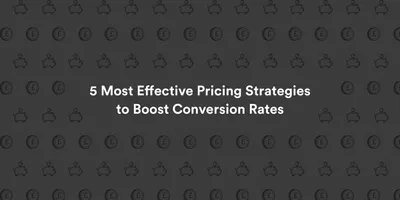5 Most Effective Pricing Strategies to Boost Conversion Rates


The way pricing is presented has a large influence on a potential customer, both on a conscious and subconscious level. The pricing techniques and strategies you decide to deploy on your site really do have the potential to make or break things in many cases. There are countless sites offering up dozens of pricing techniques that claim to boost conversions. We’ve waded through many of them and have handpicked five techniques which we feel are the ones that are the most tried and tested and have the most research backing them.
Research conducted by The University Of Chicago and MIT found that prices with numbers ending in nine were, in many cases, even more persuasive to consumers than cheaper prices. Whilst running a test on catalogues for a US mail order company they found that the catalogue with prices such as “$39.00” achieved 40% higher sales than the same catalogue where the pricing was “$34.00”.
Fascinating stuff.
An illuminating study by the University Of Yale uncovered that if two similar products are priced at the same rate then the consumer is much more likely to buy neither compared to when the prices of the two similar products are even slightly different. They ran tests on packets of chewing gum and found that when two similar packs of gum were the same price then 46% of consumers made a purchase decision but when the prices were slightly different (difference of 2 cents) then 77% made a purchase decision.
Bundling is when you group a set of complimentary or similar products together and offer a discount on the group or bundle compared to if the products in the bundle were purchased separately. The technique is heavily used in the offline world (prominent examples include fast food chains like McDonalds as well as health and beauty retailers) but it is something that is slightly less common online but is used quite regularly by big e-tailers like Amazon.
How you frame the price of a good or service can have a profound effect on its sales. For example, if you are selling expensive subscription software to big corporations you could frame the price as $2000 per year. But alternatively could frame it as $166.60 per month, or even $41.60 per week. Each of those prices is effectively the same but $41.60 per week may be perceived differently by the potential customer and this perception may influence sales.
A fascinating neuro-imaging study by Elsevier uncovered that prices that are higher in fact activate neural circuits in the brain that are associated with anticipating loss. So this price perception is something that is very real.
Anchoring is the name given to the strategy of placing other similar products or services of varying prices around a particular product – the goal is to inform the potential customer of the value of the particular product you are most influencing them to buy. If you present a premium version of product besides the standard version, then all of a sudden the standard product looks to be better value for money.
Many companies implement price anchoring. In the B2B world, SaaS software companies implement it heavily and in the B2C world huge companies like Apple use it extensively.
Co-Founder of MadeByShape. Most of my blogs are about business related aspects, not just web design.